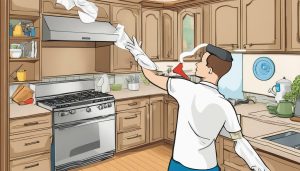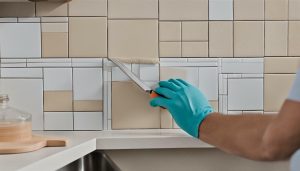Keeping your kitchen drain clear is crucial for the smooth running of your home. A clogged kitchen drain can cause a foul smell and even result in standing water, which can attract pests and create a breeding ground for bacteria and mold. One of the most effective solutions for a clogged kitchen drain is to use a drain snake. In this article, we will guide you through the process of snaking out your kitchen drain, step by step.
Key Takeaways:
- Regular maintenance and proper usage are crucial to prevent clogs in the kitchen drain system
- Common signs of a clogged kitchen drain include slow drainage, unpleasant odors, and gurgling sounds
- Wearing protective gloves and eye goggles and clearing the area around the sink are necessary safety measures when snaking out a kitchen drain
- Preventive measures, such as disposing of food waste properly, using drain screens, and regular maintenance routines can help to maintain a clear kitchen drain
- For persistent or severe clogs, seeking professional help may be necessary
Understanding the Kitchen Drain System
The kitchen drain system consists of various parts, including the sink, drainpipe, garbage disposal, and dishwasher. The sink is where water flows from, and the drainpipe is responsible for carrying wastewater out of the home. The garbage disposal and dishwasher are additional components that can contribute to clogs if not used properly.
Kitchen sink clogs are typically caused by food waste, grease, and soap scum buildup. To prevent clogs from occurring, it’s essential to be mindful of what goes down the drain. Avoid pouring grease or oil down the drain, use a strainer to catch food particles, and run hot water and dish soap down the drain regularly to break down buildup.
Plumbing Tips for Kitchen Drain:
- Avoid using chemical drain cleaners as they can damage pipes and worsen clogs.
- Regularly pour hot water and vinegar down the drain to dissolve grease and prevent buildup.
- Use a plunger to unclog minor blockages before resorting to a drain snake.
- Have your pipes inspected by a professional plumber if you experience frequent clogs or slow drainage.
Signs of a Clogged Kitchen Drain
Dealing with a clogged kitchen sink can be frustrating and time-consuming, but it’s important to address the issue as soon as possible. Here are some common signs that your kitchen drain may be clogged:
- Water draining slowly or not at all
- Foul odors coming from the sink
- Gurgling or bubbling sounds when the sink is in use
- Water backing up into the dishwasher or surrounding area
If you notice any of these symptoms, it’s important to take action immediately. Ignoring a clog can lead to more significant plumbing issues down the road.
If you suspect that your kitchen drain is clogged, there are some quick solutions that can help in the short term. For example, you can try pouring boiling water down the drain or using a plunger to force the clog out. However, these methods are not always effective, and they may only provide temporary relief.
To fully remove clogs from your kitchen drain, you will likely need to snake the drain. This involves using a drain snake to physically break up and remove the blockage. The following sections will provide a step-by-step guide to snaking out your kitchen drain and preventing future clogs.
Gathering the Required Tools
Before snaking out your kitchen drain, it’s important to gather the necessary tools. The most important tool you’ll need is a kitchen drain snake. You can purchase a drain snake at most hardware stores or online, or you can make one yourself using a wire hanger. It’s important to note that a homemade drain snake may not be as effective as a store-bought one, but it can still do the job if used properly.
In addition to a drain snake, you’ll need some protective gear. Wear gloves to protect your hands from any debris or bacteria that may be present in the drain. Eye goggles are also recommended to protect your eyes from any splashing water or debris.
Lastly, make sure you have an empty bucket or container and some towels on hand to clean up any messes that may occur during the snaking process.
Preparation and Safety Measures
Before snaking out your kitchen drain, it’s crucial to take the necessary precautions to ensure your safety and prevent any damage to your plumbing system.
Protective Gear
Wear protective gloves and eye goggles to shield your hands and eyes from any potential splashes or debris. Drain snakes can be sharp and may cause injuries if mishandled.
Clear the Area
Remove any items surrounding the sink and give yourself enough space to move freely. This will allow you to work more efficiently and avoid any accidents.
Once you’re ready, turn off the water supply to the sink and remove the drain stopper or strainer to gain access to the drain opening.
Snaking Out the Kitchen Drain
Now that you’ve gathered all the necessary tools and taken safety precautions, it’s time to get to work and snake out your kitchen drain. Follow these steps to effectively unclog your drain:
- Insert the snake: Insert the head of the drain snake into the drain opening and begin turning the handle clockwise. This will help the snake move through the pipes and break up any clogs or blockages in its way.
- Maneuver the snake: Continue to turn the handle as you guide the snake through the pipes. Be sure to move the snake up and down as well as side to side to ensure it can navigate through any bends or turns in the pipes.
- Break up the clog: Once you’ve reached the clog, use the snake to break it up into smaller pieces and push it through the pipes. You may need to turn the handle back and forth or apply more pressure to break through tough clogs.
- Retrieve the snake: Once you feel the snake has cleared the clog, slowly retract it from the drain opening. Be sure to wipe down the snake with a cloth as you remove it to avoid dripping any debris onto your floor or countertop.
It’s important to note that while snaking out your kitchen drain can be an effective solution for many clogs, it may not work in all cases. If you encounter any resistance or the clog does not clear fully, you may need to repeat the process or seek professional assistance.
Additionally, be cautious when using a drain snake to avoid causing any damage to your pipes. Avoid forcing the snake through bends or turns, as this can lead to pipe damage or further blockages.
By following these steps and taking proper precautions, you can effectively snake out your kitchen drain and restore proper drainage to your sink.
Flushing and Testing the Drain
After successfully snaking out your kitchen drain, it is essential to flush the drain to remove any remaining debris and ensure the flow is smooth. The following steps will guide you through the process:
- Boil Water: Start by boiling a pot of water on your stove. This will help to dissolve any remaining grease or residue on the inside of the pipes.
- Pour Hot Water Down the Drain: Once the water has boiled, carefully pour it down the drain. Be cautious not to splash hot water on yourself. The hot water will help to flush out any remaining debris.
- Test the Drain: Run the water for a few minutes and observe if there are any signs of slow drainage or blockages. If the water flows smoothly, your kitchen drain is now unclogged.
It is advisable to regularly flush your kitchen drain with hot water to prevent future clogs. Additionally, avoid pouring grease, oils, and large food particles down the drain, and use a drain screen to catch any small particles that could accumulate and cause blockages.
Preventive Measures for a Clear Kitchen Drain
Having to snake out your kitchen drain can be a hassle, but there are several preventative measures you can take to avoid future clogs.
- Dispose of food waste properly: Avoid pouring oil, grease, or large food particles down the drain. Instead, scrape any leftover food into the trash or compost bin.
- Use drain screens: Invest in a drain screen or strainer to catch any loose debris before it enters the pipes.
- Regular maintenance routines: Consider flushing your drain with hot water and baking soda every month to keep it clear. You can also pour vinegar down the drain to help break down any buildup.
By following these simple plumbing tips for your kitchen drain, you can save yourself the hassle of having to unclog your kitchen drain frequently.
However, if you do experience persistent clogs despite your best efforts, it may be time to seek professional help. A plumbing expert can assess the situation and offer effective solutions to keep your kitchen drain flowing smoothly.
Professional Help for Persistent Clogs
While snaking out your kitchen drain can be a simple and effective solution for most clogs, there are cases where professional assistance may be necessary. Persistent clogs that resist multiple attempts at snaking or recurring clogs despite preventive measures may indicate a more severe issue.
Additionally, if DIY attempts at snaking out your drain result in damage to the pipes or fixture, it may be time to call in a plumber. A trained professional can assess the situation, identify the root cause of the problem, and provide a long-term solution.
When searching for a reliable plumber, it’s important to do your research and check for proper licensing and insurance. Reading reviews and getting recommendations from trusted sources can also help you find a reputable professional.
While seeking professional help may come with an additional cost, it can save you time and frustration in the long run. In complex cases, attempting to fix the issue yourself can lead to further damage, ultimately costing more to repair. Knowing when to call in a professional can ensure the problem is resolved quickly and efficiently.
Remember, preventing clogs before they occur is always the best course of action. By following proper usage and maintenance tips, you can reduce the likelihood of persistent clogs and the need for professional assistance.
DIY vs. Professional Drain Snaking
Deciding whether to snake out your kitchen drain as a DIY project or hire a professional plumber can depend on several factors. Here are some pros and cons of each option to consider:
DIY Drain Snaking
- Pros:
- Cheaper: Purchasing a drain snake or making one yourself can save money compared to hiring a plumber.
- Convenient: You can snake out your drain at any time that is convenient for you, without having to schedule an appointment.
- Easy clogs: If the clog is small and close to the surface, you may be able to easily snake it out yourself with minimal effort.
- Cons:
- Complicated clogs: If the clog is deep or complex, you may not have the necessary equipment or expertise to effectively snake it out, potentially leading to further damage.
- Risk of injury: Snaking out a drain can be dangerous, especially if you do not take proper safety measures such as wearing gloves and eye goggles.
Professional Drain Snaking
- Pros:
- Expertise: Professional plumbers have the knowledge and experience to effectively locate and snake out deep or complex clogs without causing damage.
- Guarantee: Many plumbers offer guarantees or warranties on their work, providing peace of mind and protection against future clogs.
- Professional equipment: Plumbers have access to specialized equipment, such as video cameras, that can locate and diagnose clogs more precisely.
- Cons:
- Expensive: Hiring a professional plumber can be more expensive than attempting to snake out the drain yourself, especially for simple clogs.
- Inconvenient: You will need to schedule an appointment and may have to wait for the plumber to arrive, which can be inconvenient if you have a busy schedule.
Ultimately, the decision to attempt snaking out your kitchen drain as a DIY project or hire a professional plumber depends on your personal circumstances and the severity of the clog. If you are unsure or uncomfortable with attempting to snake out the drain yourself, it is best to seek professional help to avoid causing further damage.
Conclusion
Snaking out a kitchen drain may seem like a daunting task, but with the right tools and knowledge, it can be done effectively and efficiently. Remember, a clogged kitchen drain can lead to unpleasant odors, slow drainage, and even potential water damage, so it’s crucial to take action and keep your drain clear.
By following the step-by-step guide outlined in this article, you can easily snake out your kitchen drain and restore proper flow. Don’t forget to take preventive measures, such as properly disposing of food waste and regularly maintaining your drain, to reduce the risk of future clogs.
If you encounter persistent or severe clogs, it may be wise to seek the help of a professional plumber. While DIY snaking can save on cost, a professional can provide expertise and tackle more complex cases.
So, don’t let a clogged kitchen drain get the best of you. Take action and use this guide to effectively snake out your kitchen drain!
FAQ
Q: How often should I snake out my kitchen drain?
A: It is recommended to snake out your kitchen drain at least once every few months to prevent clogs and maintain optimal drainage.
Q: Can I use other methods to unclog my kitchen drain instead of a drain snake?
A: While a drain snake is often the most effective tool for clearing clogs in a kitchen drain, there are alternative methods such as using a plunger or using a mixture of baking soda and vinegar. However, these methods may not be as effective for stubborn or deep clogs.
Q: Are there any safety precautions I should take when snaking out my kitchen drain?
A: Yes, it is important to wear protective gloves and eye goggles while snaking out your kitchen drain to avoid any potential injury or exposure to harmful substances. Additionally, make sure to clear the area around the sink to prevent any accidents or damage.
Q: What do I do if the clog in my kitchen drain persists even after snaking it out?
A: If the clog in your kitchen drain persists even after snaking it out, it may be necessary to seek professional help. A reliable plumber will have the tools and expertise to resolve complex or persistent clogs.
Q: Can I use a homemade drain snake instead of purchasing one?
A: Yes, a DIY drain snake can be used as an alternative to a purchased one. This can be made using a wire coat hanger or a flexible plastic rod. However, DIY options may not be as effective as a commercial drain snake, especially for tougher clogs.

It’s me, Amber Hayden, the heart and soul behind SagarmathaOnlineMedia.com. From a young age, I’ve been head over heels for everything home-related, from interior decor to gardening. I’m the type who can’t resist a well-crafted piece of furniture, and I firmly believe that a home isn’t complete without a pet or two. But it’s not just about creating pretty spaces for me. I’m all about making homes that tell a story reflecting the people living there. SagarmathaOnlineMedia.com is my way of sharing this passion with you. Whether you’re looking for tips to jazz up your living room, advice on pet care, or ideas to make your garden bloom, I’m here to help. So, let’s embark on this journey together and make your house a home!



